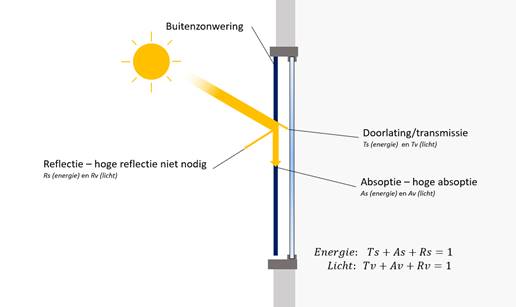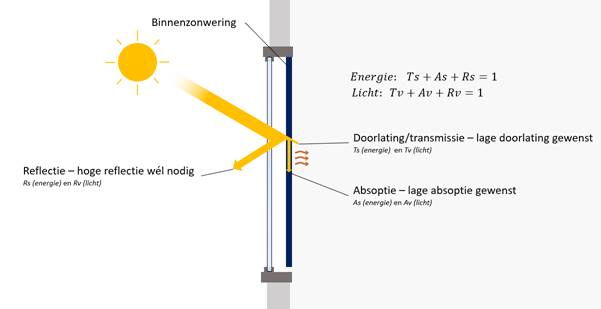

CL BS EPG
This allows you to choose whether or not to install
regular sun protection by the window. When you turn on the check box for sun
blinds, all of the following settings appear. This setting applies regardless of
a normal window or climate window.
With the placement there is a choice of:
• Outside: Sun blinds placed on the outside of the window such as screens
• Between panes: Blinds placed in or between the windows such as blinds.
• Inside: Sun blinds placed on the inside of the window
|
|
ISSO Handboek Zonnestraling en Zontoetreding (2009) Bijlage E |
CL BS
The control gives a choice
how to control the sunblind. You can then define this choice at the blinds
switch level under the building control building template.
Pay attention! This setting is linked to Building Operations> Blinds control settings.
• Manual; the sunblind is controlled manually. Depending on the setting under Building Regulations, this can be continuously open, continuously closed or controlled via a certain switching level.
• Automatically; the sunblind is regulated automatically. Depending on the setting under Building Regulations, this can be continuously open, continuously closed or controlled via a certain switching level.
Enter the type of blinds here. There is a difference between inside and between / outsideblinds. You can choose from the following types:
Outside- en tussen blinds
|
Energy |
Good |
Moderate |
Bad |
|
Transmission ts |
0.03 |
0.12 |
0.19 |
|
Absoprtion as |
0.92 |
0.43 |
0.14 |
|
Reflection rs |
0.05 |
0.45 |
0.67 |
|
Light |
|
|
|
|
Transmission (LTA) tv |
0.03 |
0.11 |
0.19 |
|
Reflection tv |
0.05 |
0.48 |
0.76 |
|
Absoption tv |
0.92 |
0.41 |
0.05 |
Binnen zonwering
|
Energy |
Good |
Moderate |
Bad |
|
Transmission ts |
0.05 |
0.05 |
0.10 |
|
Absoprtion as |
0.20 |
0.52 |
0.81 |
|
Reflection rs |
0.75 |
0.43 |
0.09 |
|
Light |
|
|
|
|
Transmission (LTA) tv |
0.06 |
0.04 |
0.10 |
|
Reflection tv |
0.74 |
0.42 |
0.09 |
|
Absoption tv |
0.20 |
0.54 |
0.81 |


In collaboration with blinds suppliers, standard blinds types have been determined that you can choose from; poor, moderate or good. The current market values have been applied to these categories as specifications. The order from good to bad is based on the g-value in combination with HR ++ glass. The g value represents the ratio between the incident solar radiation and the incoming solar radiation. The lower the g value, the less solar heat enters the building.
With blinds, the most important factor is the transmission, or transmission, of energy. With good blinds, this value will be low and high with poor blinds. There is also a difference between inside and outside sun blinds.
With blinds, the degree of reflection is important, while a higher reflection ensures a lower transmission of energy. With solar shading, it is not desirable to have high absorption, because you then create large areas of radiation.
With outdoor blinds, the absorption is less important, because the absorbed heat does not radiate inwards. As a result, the value for absorption, as opposed to inside solar protection, can be higher.
CL BS
This is the direct energy transmission [αe, TE%] and indicates the percentage
of energy that is transmitted through the glass. This is the part of the
directly transmitted solar energy, in other words the transmitted solar
radiation
If the transmission [τe] is not known, but the absorption [αe] and energy reflection [ρe] are, then the value of the transmission can be deduced from the following formula:

 .
.
CL BS
Energy absorption [αe, AE1%+AE2%] is the part
of the solar energy absorbed by the glass. This glass property must be measured
in accordance with NEN-EN 410: 2011.
If the absoprtion [αe] is not known, but the
absorption [τe] and energy reflection
[ρe] are, then the value of
the transmission can be deduced from the following formula:
 .
.
CL BS
This is the light entry factor [[τv, TL%] or light
transmission and gives the ratio between the incoming and the striking visible
solar radiation with a perpendicular angle of incidence. This coefficient is
used to determine the light in the room and is used to switch the lighting. The
higher the LTA value, the more visible light and heat enters. This glass
property must be measured in accordance with NEN-EN 410: 2011.
CL BS
The visible reflection [ρv, RLe%], or light
reflection, indicates the percentage of visible light that is reflected by the
glass. The higher the reflection, the more light is reflected. This glass
property must be measured in accordance with NEN-EN 410: 2011.
Make sure that the light reflection [ρv] is different from the energy reflection [ρe] of glass.
CL
If there are indoor blinds, the convection factor for
artificial light can be entered. The heat radiation from the artificial light
ensures that the indoor sun protection heats up and also radiates heat again.
The influence of the convection factor also depends on the specified
illuminance.
EPG
Fixed outdoor sun
protection is an option that can only be applied for an EPG calculation. This
concerns outside sun protection that is always present. With fixed awning (as
with scattering glazing) the time-average sun glare factor ggl is
used and this is calculated from the specified g value at sun height 45º and the
g value for isotropic diffuse solar radiation.
EPG
Scattering glazing is an
option that can only be used for an EPG calculation. In the case of scattering
glazing, the time-average solar entry factor ggl is used and this is calculated
from the specified g value at sun height 45º and the gg value for
isotropic diffuse solar radiation.
EPG
The g value of the glass as
determined at a sun height of 45º. This value can be specified if fixed external
sun protection or scattering glazing is chosen, and this is used for the
calculation of the ggl value.
EPG
The g value for isotropic
diffuse solar radiation determined in accordance with ISO 15099. This value can
be specified if fixed external sun protection or scattering glazing has been
chosen, and this is used for the calculation of the ggl value.
|
EPG |
NEN 7120, Paragraph 11.7.2 Solar factor daylight openings |
|
With a Dutch climate façade, air is extracted between the inside blinds and the glass. As a result, less heat will enter the room. The ventilation is part of the LBK and cannot be used in combination with natural ventilation.
In Vabi Elements you can select the Dutch climate façade, if there are blinds inside. Total ventilation at the window will also be assumed for the Dutch climate façade.
|
|